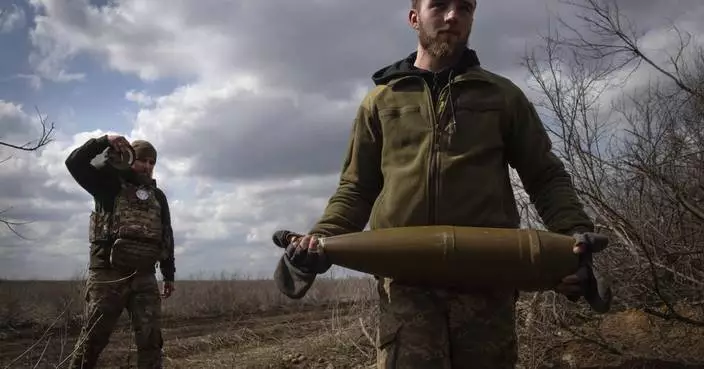For the second month in a row, U.S. officials tasked with carrying out federal public safety policy for tribes missed a deadline to provide input on legislation to curb violence against Native American women.
U.S. Sen. John Hoeven, R-North Dakota, had set a July 8 deadline for Interior and Justice Department officials to offer positions and guidance on a slate of bills that aim to stem domestic violence, homicides and disappearances of Native Americans on tribal lands.
Hoeven, who chairs the U.S. Senate Committee on Indian Affairs, had set the deadline for both departments after criticizing officials for filing late testimony and saying they arrived at a hearing in June unprepared to fully weigh in on legislation.
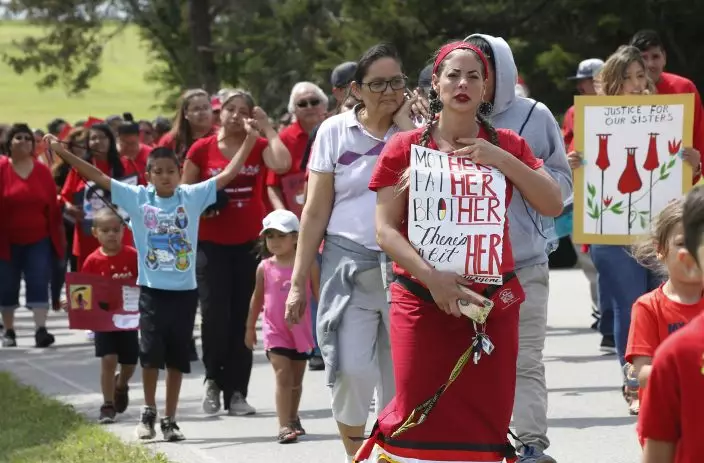
FILE - In this Friday, June 14, 2019, file photo, Miranda Muehl, of Mustang, Okla., marches during a march to call for justice for missing and murdered indigenous women at the Cheyenne and Arapaho Tribes of Oklahoma in Concho, Okla. U.S. Senate staffers say officials missed a second deadline on July 8 to offer input on bills on Native American safety, and only one department has since provided “partial comment.” (AP PhotoSue Ogrocki, File)
A week after the new deadline passed, a spokesman for Sen. Tom Udall said Monday that Justice officials had yet to provide positions on the legislation, while the Interior only provided "partial comment." Udall, D-New Mexico, is a co-chairman of the committee with Hoeven.
An Indian Affairs committee spokeswoman said in response to inquiries from The Associated Press that the Interior's guidance on bills had been submitted late, though she did not say which day. She and Interior officials would not release the documents that had been sent to the committee.
Meanwhile, a spokesman for the Justice Department told the AP late Monday that the department is working as quickly as possible to provide positions on the bills, and had provided a status update to the committee chairman's office.
"I was deeply frustrated when DOI and DOJ showed up completely unprepared to our committee's hearing on these critical bills," Udall said in an emailed statement. "Weeks later, the administration still has not delivered on its promised 'renewed commitment' to tribal public safety, failing to meet this deadline even after being granted an extension."
Lawmakers need feedback from the Trump administration in their effort to take necessary legislative action to address public safety for Native Americans, Udall said. In recent months, a wave of bi-partisan legislation in Congress has sought to expand coordination for crime-fighting among federal agencies and expand tribes' ability to prosecute non-Native Americans in sex assault cases and crimes against law enforcement and children.
The bills come in response to a national movement to build awareness of the deaths and disappearances of Native American women, who are victimized at alarming rates. The most recent federal figures show more than half have encountered sexual and domestic violence at some point during their lives, with advocates saying the population is left vulnerable in part because their safety has been disregarded or ignored over the years.
In May, U.S. Attorney General William Barr visited Alaska, where tribal representatives told him about the lack of law enforcement in villages and slow response times to calls.
At last month's committee hearing, Tracy Toulou, director of the Justice Department's Office of Tribal Justice, said that visit had led the department's leadership to express a renewed commitment to public safety among tribes and Alaska Native villages.
He also apologized for the late testimony, explaining that the bills are complex and require wide review within the Justice Department. The review process can be lengthy and span multiple agencies.
Charles Addington — the director of the Office of Justice Services, which falls under the Interior's Bureau of Indian Affairs — also apologized for the late filing of testimony. He said his comments had been held up during a clearance process.
The Senate's Indian Affairs committee has been seeking immediate comment from federal officials on five specific bills, including Savannah's Act. It proposes to increase tribal law enforcement's access to criminal databases, increase data collection on missing persons cases and set new guidelines for law enforcement's response to reports of missing Native Americans.
KYIV, Ukraine (AP) — A big, new package of U.S. military aid will help Ukraine avoid defeat in its war with Russia. Winning will still be a long slog.
The arms and ammunition in the $61 billion military aid package should enable Ukraine to slow the Russian army's bloody advances and block its strikes on troops and civilians. And it will buy Ukraine time — for long-term planning about how to take back the fifth of the country now under Russian control.
“Ultimately it offers Ukraine the prospect of staying in the war this year,” said Michael Clarke, visiting professor in war studies at King’s College London. “Sometimes in warfare you’ve just got to stay in it. You’ve just got to avoid being rolled over.”
The U.S. House of Representatives approved the package on Saturday after months of delays by some Republicans wary of U.S. involvement overseas. It was passed by the Senate on Tuesday, and President Joe Biden said he would sign it Wednesday.
The difference could be felt within days on the front line in eastern and southern Ukraine, where Russia’s much larger army has been slowly taking territory against massively outgunned Ukrainian forces.
The aid approval means Ukraine may be able to release artillery ammunition from dwindling stocks that it has been rationing. More equipment will come soon from American stocks in Poland and Germany, and later from the U.S.
The first shipments are expected to arrive by the beginning of next week, said Davyd Arakhamia, a lawmaker with Ukrainian President Volodymyr Zelenskyy’s Servant of the People party.
But opposition lawmaker Vadym Ivchenko, a member of the Ukrainian parliament’s National Security, Defense and Intelligence Committee, said logistical challenges and bureaucracy could delay shipments to Ukraine by two to three months, and it would be even longer before they reach the front line.
While details of the shipments are classified, Ukraine’s most urgent needs are artillery shells to stop Russian troops from advancing, and anti-aircraft missiles to protect people and infrastructure from missiles, drones and bombs.
What’s coming first is not always what front-line commanders need most, said Arakhamia, the Ukrainian lawmaker. He said that even a military giant like the U.S. does not have stockpiles of everything.
“The logic behind this first package was, you (the U.S.) finds our top priorities and then you see what you have in the warehouses,” Arakhamia said. “And sometimes they do not match.”
Hope for future breakthroughs for Ukraine still hangs on more timely deliveries of Western aid, lawmakers acknowledge.
Many experts believe that both Ukraine and Russia are exhausted by two years of war and won’t be able to mount a major offensive — one capable of making big strategic gains — until next year.
Still, Russia is pushing forward at several points along the 1,000-kilometer (600-mile) front, using tanks, wave after wave of infantry troops and satellite-guided gliding bombs to pummel Ukrainian forces. Russia is also hitting power plants and pounding Ukraine’s second-largest city, Kharkiv, which is only about 30 kilometers (some 20 miles) from the Russian border.
Ivchenko said the goal for Ukraine’s forces now is to “hold the line” until the bulk of new supplies arrive by mid-summer. Then, they can focus on trying to recapture territory recently lost in the Donetsk region.
“And probably ... at the end of summer we’ll see some movement, offensive movement of the Ukrainian armed forces,” he said.
Some military experts doubt Ukraine has the resources to mount even small offensives very soon.
The U.S. funding “can probably only help stabilize the Ukrainian position for this year and begin preparations for operations in 2025,” said Matthew Savill, director of military sciences at the Royal United Services Institute, a think tank.
In the best-case scenario for Ukraine, the American aid will give commanders time to reorganize and train its army — applying lessons learned from its failed summer 2023 offensive. It may also galvanize Ukraine’s allies in Europe to increase aid.
“So this just wasn’t about Ukraine and the United States, this really affected our entire 51-country coalition,” said U.S. Congressman Bill Keating, a Democrat who visited Kyiv on Monday as part of a four-member congressional delegation.
Zelenskyy insists Ukraine's war aim is to recapture all its territory from Russia — including Crimea, seized illegally in 2014. Even if the war ultimately ends through negotiation, as many experts believe, Ukraine wants to do that from as strong a position as possible.
Whatever happens on the battlefield, Ukraine still faces variables beyond its control.
Former U.S. President Donald Trump, who seeks to retake the White House in the November election, has said he would end the war within days of taking office. And the 27-nation Europe Union includes leaders like Hungarian President Viktor Orbán and Slovakian Prime Minister Richard Fico, who have opposed arming Ukraine.
Ukraine’s allies have held back from supplying some arms out of concern about escalation or depleting their own stocks. Ukraine says that to win the war it needs longer-range missiles it could use for potentially game-changing operations such as cutting off occupied Crimea, where's Russia's Black Sea fleet is based.
It wants Army Tactical Missile Systems, known as ATACMs, from the U.S. and Taurus cruise missiles from Germany. Both governments have resisted calls to send them because they are capable of striking targets deep within Russian territory.
The new bill authorizes the president to send Ukraine ATACMS “as soon as practicable.” It's unclear what that will mean in practice.
Sometimes, promised weapons have arrived late, or not at all. Zelenskyy recently pointed out that Ukraine is still waiting for the F-16 fighter jets it was promised a year ago.
Meanwhile, Russia is using its advantage in troops and weapons to push back Ukrainian forces, perhaps seeking to make maximum gains before Ukraine's new supplies arrive.
For weeks it has pummeled the small eastern city of Chasiv Yar, at the cost of 900 soldiers killed and wounded a day, according to the U.K. Ministry of Defense.
Capturing the strategically important hill town would allow them to move toward Sloviansk and Kramatorsk, key cities Ukraine controls in the eastern region of Donetsk. It would be a significant win for Russian President Vladimir Putin, who Western officials say is bent on toppling Ukraine’s pro-Western government.
Russian pressure was aimed not just at gaining territory, but on undermining Zelenskyy and bolstering critics who say his war plan is failing, said Clarke of King's College London.
The U.S. aid package decreases the likelihood of a political crisis in Ukraine, and U.S. Speaker Mike Johnson deserves credit for pushing it through Congress, he said.
"He held history in his hands,” Clarke said.
Follow AP’s coverage of the war in Ukraine at https://apnews.com/hub/russia-ukraine

From left, U.S. representatives Nathaniel Moran, R-Tx, Tom Kean Jr, R-NJ, Bill Keating, D-Mass, and Madeleine Deane, D-Pa, talk to journalists during a joint news conference outside Saint Michael cathedral in Kyiv, Ukraine, Monday, April 22, 2024. A newly approved package of $61 billion in U.S. aid may prevent Ukraine from losing its war against Russia. But winning it will be a long slog. (AP Photo/Francisco Seco)
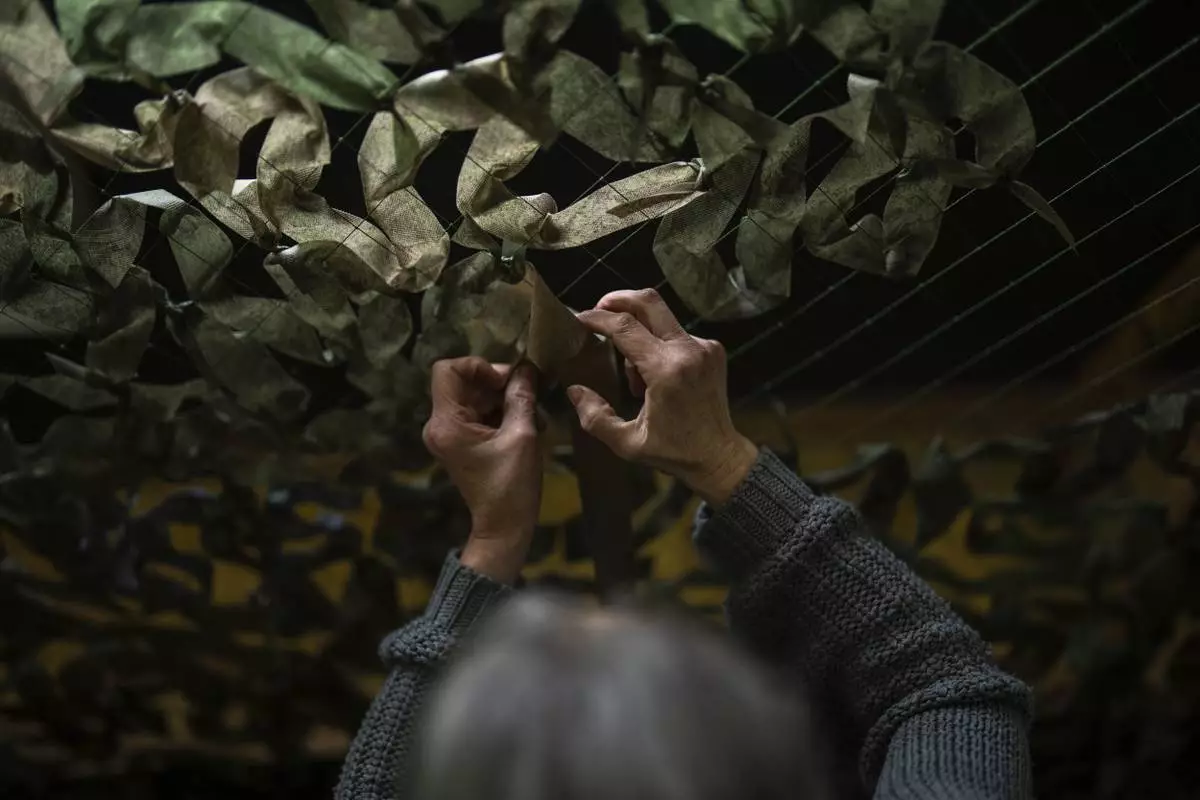
A volunteer makes a camouflage net at a facility producing material for Ukrainian soldiers in Kyiv, Ukraine, Monday, April 22, 2024. A newly approved package of $61 billion in U.S. aid may prevent Ukraine from losing its war against Russia. But winning it will be a long slog. (AP Photo/Francisco Seco)
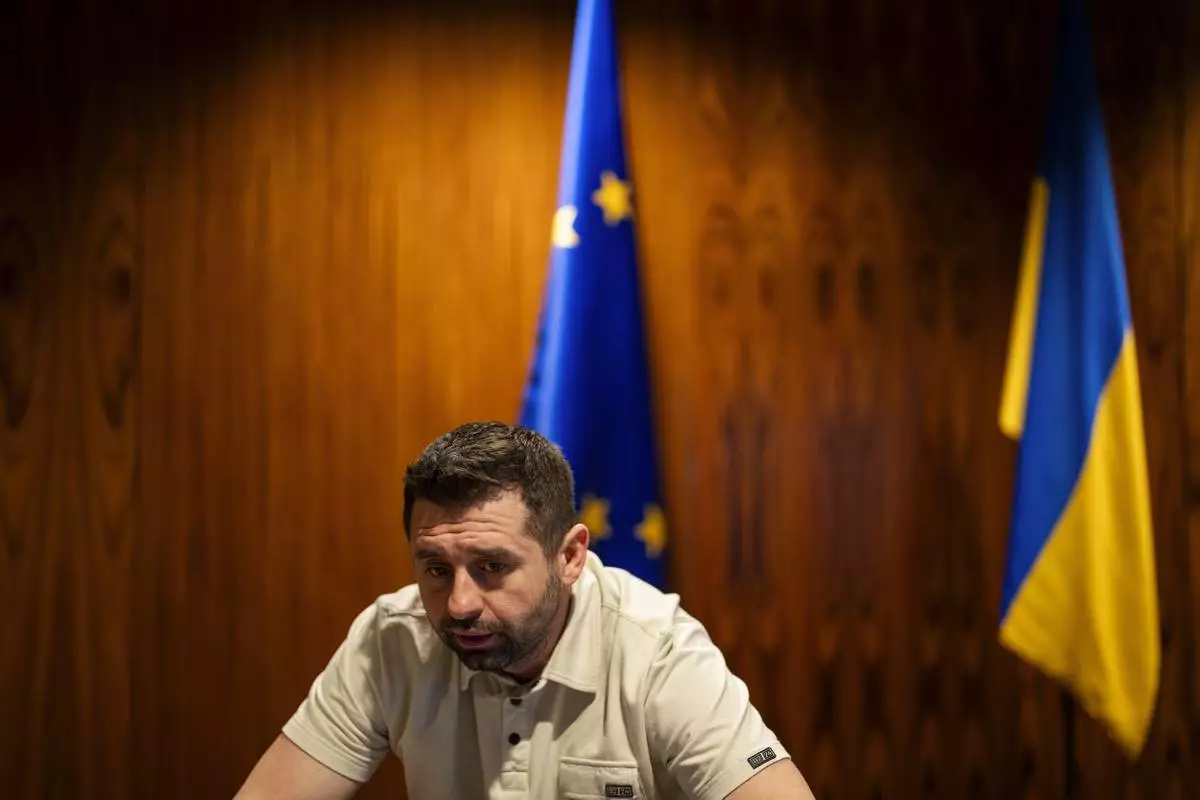
Davyd Arakhamia, a lawmaker with Ukrainian President Volodymyr Zelenskyy's Servant of the People party, talks during an interview with Associated Press in Kyiv, Ukraine, Monday, April 22, 2024. (AP Photo/Francisco Seco)
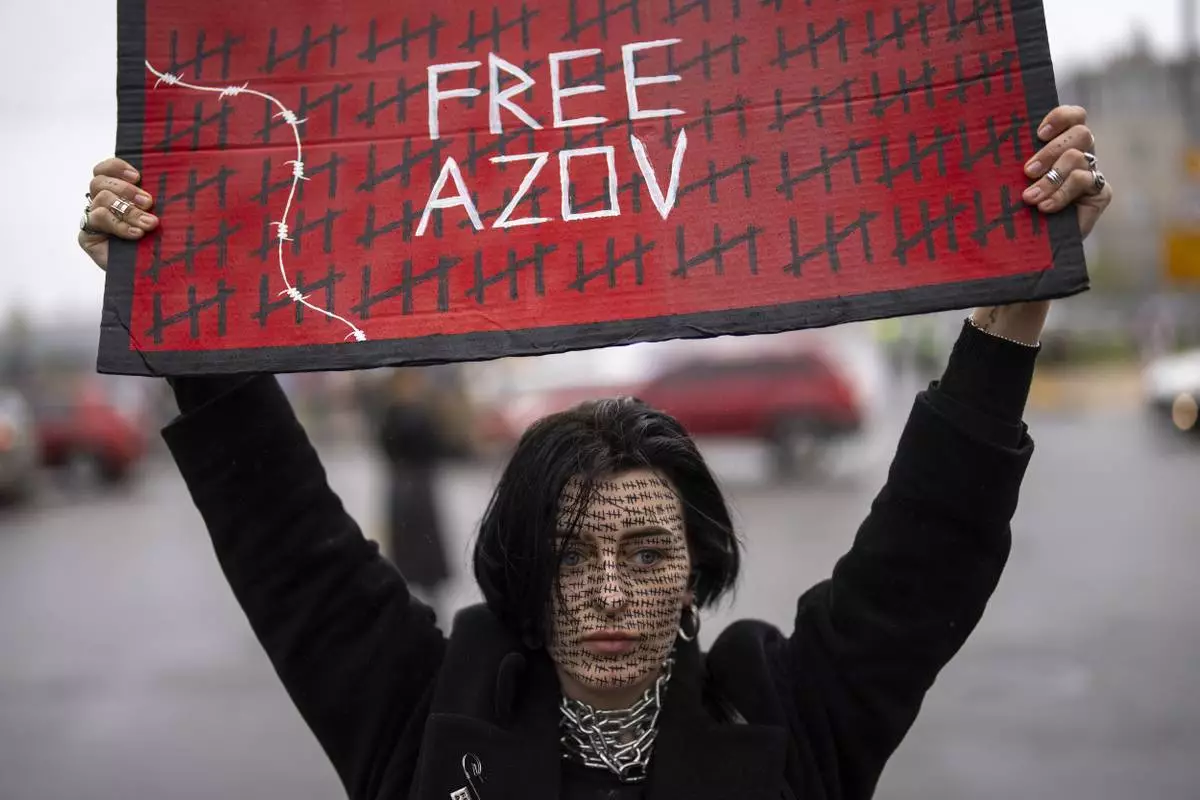
A woman rallies to raise awareness on the fate of Ukrainian prisoners of war in Kyiv, Ukraine, Sunday, April 21, 2024. (AP Photo/Francisco Seco)
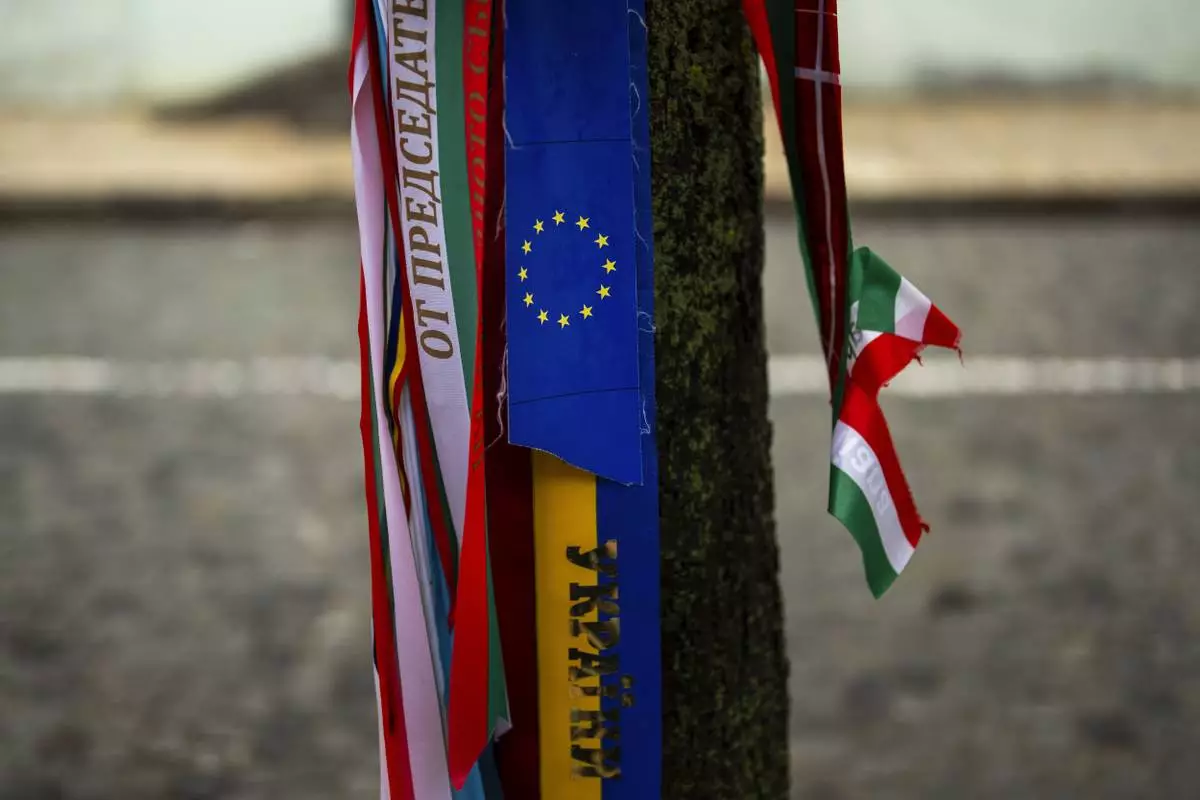
Ribbons with the colors of the European Union and Ukraine are attached to a tree next to memorial wall of Ukrainian soldiers killed during the war in Kyiv, Ukraine, Monday, April 22, 2024. (AP Photo/Francisco Seco)
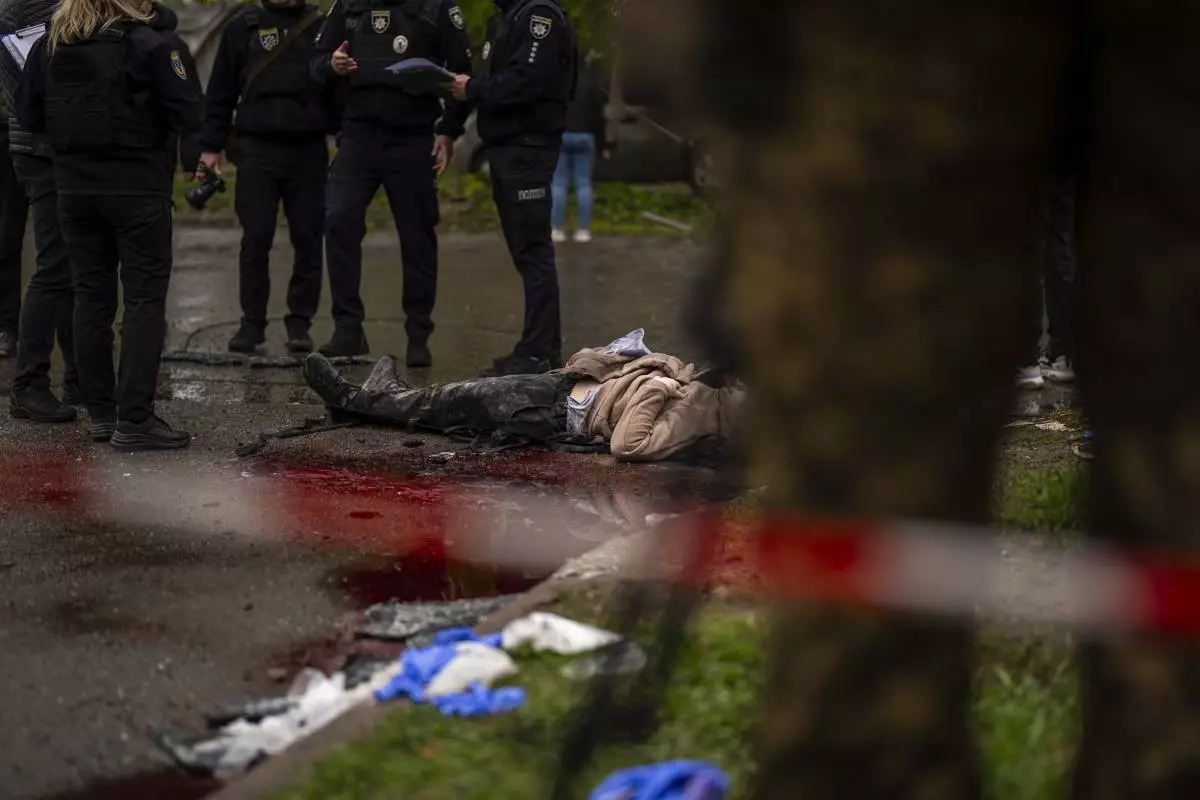
The body of a woman killed by Russian bombardment in Chernihiv, Ukraine, Wednesday, April 17, 2024. (AP Photo/Francisco Seco)

Soldiers carry the coffins of two Ukrainian army sergeants during their funeral in Lviv, Ukraine, Tuesday, April 16, 2024. (AP Photo/Francisco Seco)














